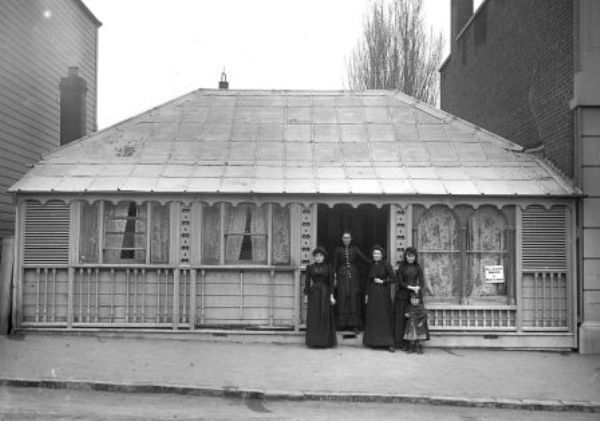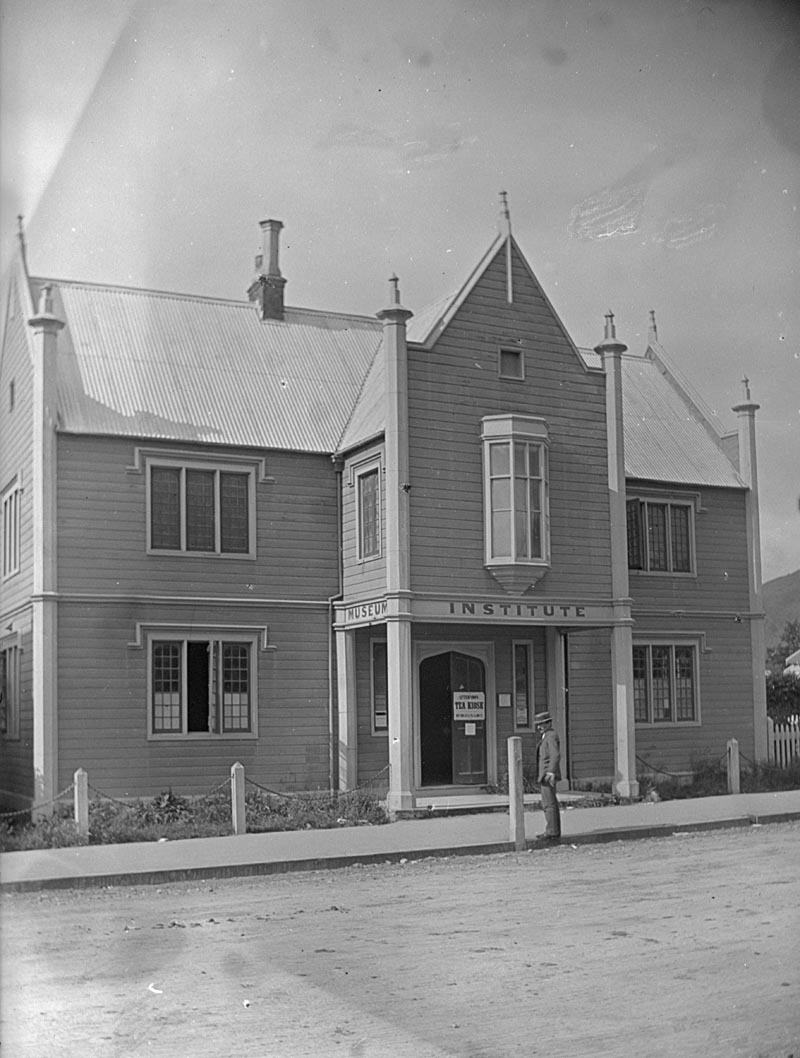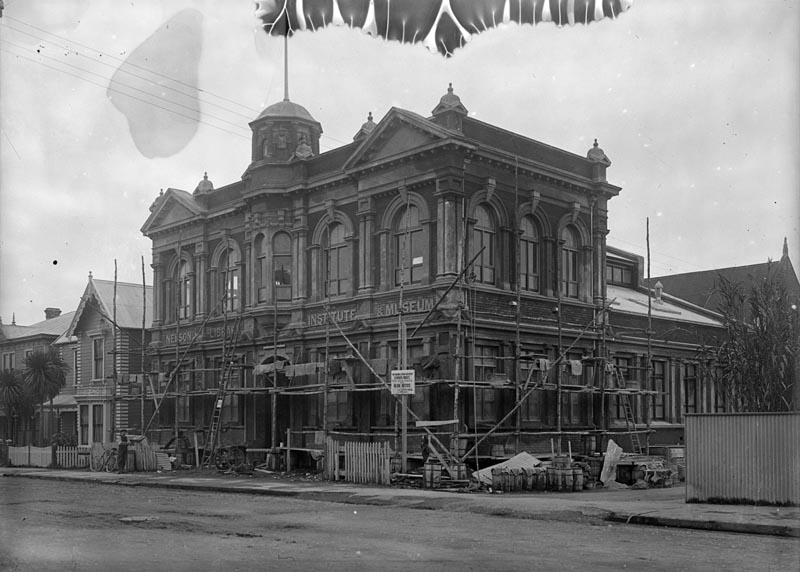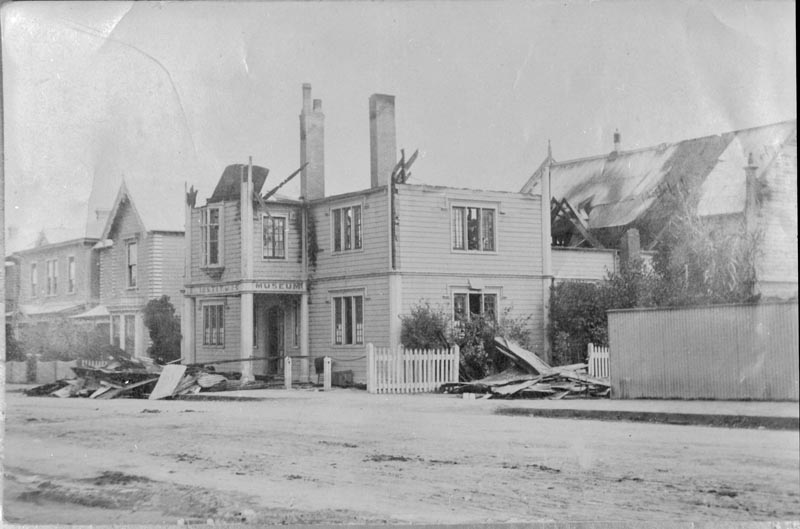Nelson Literary Scientific and Philosophic Institute
Nelson's Institute of Culture and Learning "The finest libraries in the Dominion should be like fresh air and sunlight and education - free to everyone"; said Nelson's mayor, T. A. H. Field, when laying the foundation stone for the third Nelson Institute building on 27 September 1911.
Nelson's Institute of Culture and Learning
"The finest libraries in the Dominion should be like fresh air and sunlight and education - free to everyone"; said Nelson's mayor, T.A.H. Field, when laying the foundation stone for the third Nelson Institute building on 27 September 1911. In his speech, he deplored what he saw as the desire of the original settlers to "maintain class distinctions and keep all literary, scientific and political advantages in the hands of the few."1
The Nelson Literary and Scientific Institution, or Nelson Institute, was founded in May 1841 as the New Zealand Company ships, the Whitby and Will Watch made their way to New Zealand.2 The leaders of the enterprise, which included Captain Arthur Wakefield, had a vision for: "a civic centre...consisting of a well-equipped library, a museum of history and ethnology and a philosophical society to promote intellectual development."3
With an initial collection of 700 books donated by passengers, and money sent to England for more books, journals and periodicals, a new library and reading room was built and ready for business within months of the settlers arrival in Nelson in 1842.4
A high level of illiteracy (31.3% of the population could not read in 1848)5, expensive fees and a membership process involving nomination by two members6, may be why some saw the Institute as a club for the privileged classes. No women participated in the early life of the Institute.7
The Nelson Institute remained at the top of Trafalgar Street on part of Town Acre 4458 until 1861 when a new facility catering for a library, museum and lectures was constructed on the corner of Hardy and Harley Streets. The Nelson Provincial Council wanted the Institute to broaden its activities and become a literary and mechanics institute and donated the land and a £200 grant towards the new building.9 An additional museum wing was added in 1883.10
By 1873, there were 11 public libraries, mechanics' institutes and other literary and scientific institutions throughout the Nelson province.11
On February 25, 1906, disaster struck - fire gutted much of the wooden Institute building. A crowd of people, directed by Institute president, Fred Gibbs, managed to salvage many books and museum artifacts. The library re-opened in Kings Hall, a hall also used by the Athletic Club on Bridge Street, in the block between Harley and Collingwood Street, just a week later and remained there for seven years.12
The new Institute was built of reinforced concrete at a cost of £3726, and opened by the Minister of Internal Affairs, the Honourable F.D.H. Bell13 who urged the Institute "not to fill the shelves of its library with abstruse works of science, which the ordinary man had not time to read."14 The Institute's rules said: "there was to be no lying on benches, eating, smoking, spitting or striking of matches." Conversing or reading aloud was also prohibited.15
The imposing brick-clad building in Hardy Street was the home of the Nelson Public Library for 78 years16 and then housed the Nelson Marlborough Institute of Technology's Fisheries School, having been sold to Nelson Polytechnic in 1990.17 The building was closed in 2011 due to earthquake risk and the School was relocated.
The two facilities of the Institute were separated in the mid-1960s. The public library came under the direct control of the Nelson City Council and the Museum under the administrative control of the newly-formed Nelson Provincial Museum Trust Board. The museum and its library and archives were relocated from Hardy Street to Isel Park, Stoke in 1973. An additional exhibition and education venue opened in October 2005 - on part of the original Town Acre 445 where the Institute began.18
The Nelson Literary Scientific and Philosophical Institute continues to this day with lectures and discussion groups. The Institute's 170th birthday was celebrated on 22 May 2011.
Mechanics' Institutes
Mechanics' Institutes were established in Europe and America in the early nineteenth century as educational organisations for craftsmen and skilled workers. Institutes aimed to provide education for members through lectures on science and a variety of self-improvement topics. The institutes also usually provided subscription libraries for the use of Institute members and members of the public.
In New Zealand, Mechanics' Institutes were formed very early in the European settlement period. The Auckland Mechanics' Institute was established in July 1841, and a Wellington Institute in April the following year.19
The Richmond Mechanics Institute was formed on 12 November 1846, after a well-attended public meeting. A series of lectures were delivered in the following months, including one by Charles Heaphy on ‘Astronomy'.20 The Nelson Institute began to provide lectures and classes from 1850 21, with regular classes on writing, geography, grammar and arithmetic and lectures on subjects such as poetry, mechanics and hydrostatics.22
The Nelson Institute host monthly talks at the library on a broad range of topics, puts out a quarterly Review, and participates in the annual Cawthron Scitec Expo (school science projects). In the spirit of their predecessors, they see themselves as an information conduit between the academic world and the general public. Contacted is through president, Nigel Costley, costleymarr@xtra.co.nz
2011 (updated 2025)
Story by: Joy Stephens
Sources
- Stafford, D. (1992) The Library from the sea: Nelson Public Library 1842-1992 [Nelson, N.Z.] :Friends of the Nelson Library, p. 10
- Lash, Max (1992) The Nelson Institute and its libraries. Typescript of speech given by Max D. Lash on the 28th September, 1992 prior to the unveiling of the Christopher Vine plaque.
- Brereton, C.B. (1948) The history of the Nelson Institute. Wellington, N.Z.: Reed, p. 11.
- Stafford, p. 4
- Traue, J. E (2006) Public libraries and access to reading materials in early colonial Nelson. New Zealand Libraries, 49(13):pp.465-473
- Kwasitsu, L.(1986) Early libraries in Nelson. New Zealand Libraries 45(1), pp.1-6
- Stafford, p. 7
- Nelson Provincial Museum https://www.nelsonmuseum.co.nz/news/brief-history-of-nelson-provincial-museum. Retrieved June 2023
- Stafford, p.8
- Lash
- Kwasitsu, p.2
- Brereton, pp. 57-58
- Development of Tertiary Education: http://www.theprow.org.nz/development-of-tertiary-education. Retrieved June 2011.
- Brereton, p.62
- Stafford, p 10
- Stafford, p. 11
- Old library gets new life (1990, August 9) Nelson Evening Mail; Polytechnic plans revamp of former library (1990, August 31) Nelson Evening Mail
- Nelson Provincial Museum
- Christchurch City Libraries: http://christchurchcitylibraries.com/Heritage/LocalHistory/MechanicsInstitute/ Retrieved June 2011.
- Brereton, p.27
- Verran, D. (2007) Mechanics' institutes in New Zealand. New Zealand Legacy, 19 (1):pp.13-19
- Brereton, pp. 30-31
Further Sources
Books
- the library from the sea
- Bell, C.W. (1978). Unfinished business: The second fifty years of the Nelson City Council. Nelson, N.Z.: Nelson City Council, pp.73, 75-6, 138
http://www.worldcat.org/oclc/34523816 - Brereton (1948) The history of the Nelson Institute. Wellington, N.Z.: Reed
http://www.worldcat.org/title/history-of-the-nelson-institute/oclc/11988526 - Davies, S. (1984) Bread and roses : her story. Auckland, N.Z.: Australia and New Zealand Book Co.
http://www.worldcat.org/title/bread-and-roses-sonja-davies-her-story/oclc/17576454/editions? - Constitution, rules and by-laws of the Nelson Institute (1907?) Nelson, N.Z.: Lucas & Son. (Held Nelson Public Libraries Heritage Collection)
- Mann, Shonadh (1977) F.G. Gibbs, his influence on the social history of Nelson,1890 to 1950. Thesis. Stoke, N.Z.: Nelson Historical Society.
http://www.worldcat.org/title/fg-gibbs-his-influence-on-the-social-history-of-nelson-1890-1950-being-a-thesis-submitted-for-the-degree-of-master-of-arts-in-history/oclc/154643351 - Stafford, D. (1992) The Library from the sea: Nelson Public Library 1842-1992 [Nelson, N.Z.] :Friends of the Nelson Library. https://search.worldcat.org/title/37926103
Newspapers
- Arnold, Naomi (2011, October 29) Popular science. The Nelson Mail. p.15
- Dissmeyer, T. (1992) 150th Anniversary of the Nelson Public Library. North and South, Oct 1992, p.26-27
- Jones, G. (1965,December) Church into Library: Stoke Branch . New Zealand Libraries. pp. 305-307
- Kwasitsu, L.(1986) Early libraries in Nelson New Zealand Libraries 45(1), pp.1-6
- Nelson Institute (2002) Review / Nelson Literary Scientific & Philosophic Institute 1, pp.1-2
- Nelson Provincial Museum and Library (1977) Journal of the Nelson Historical Society, 3(3), pp.12-13
http://www.nzetc.org/tm/scholarly/tei-NHSJ03_03-t1-body1-d4.html - Stokes, Rachel (2011, July) Wakefield Library Wakefield Village News, p.22-23
- Traue, J. E (2006) Public libraries and access to reading materials in early colonial Nelson. New Zealand Libraries, 49(13): pp.465-473
- Verran, D. (2007) Mechanics' institutes in New Zealand. New Zealand Legacy, 19 (1):pp13-19
Websites
- Nelson Provincial Museum https://www.nelsonmuseum.co.nz/news/brief-history-of-nelson-provincial-museum. Retrieved June 2023
- Nelson Scientific and Literary Institution Second Annual General Meeting. (1844, 6th July)Retrieved 5 July, 2011 from
http://paperspast.natlib.govt.nz/cgi-bin/paperspast?a=d&cl=search&d=NENZC18440706.2.10 - Nelson Literary Institution valuable accession of books. (1848, 27th May) Retrieved 5 July, 2011 from
http://paperspast.natlib.govt.nz/cgi-bin/paperspast?a=d&cl=search&d=NENZC18480527.2.8 - Nelson Literary Institution Annual General Meeting. (1851, 23rd August) Retrieved 5 July, 2011 from
http://paperspast.natlib.govt.nz/cgi-bin/paperspast?a=d&cl=search&d=NENZC18510823.2.6 - Nelson Institute Annual General Meeting.(1858, 20th January) Retrieved 5 July, 2011 from
http://paperspast.natlib.govt.nz/cgi-bin/paperspast?a=d&cl=search&d=NENZC18580120.2.7 - Nelson District Libraries. (1860, 16th May) Retrieved 5 July, 2011 from
http://paperspast.natlib.govt.nz/cgi-bin/paperspast?a=d&cl=search&d=NENZC18600516.2.8
Maps
- Nelson Institution Act 1859 Sess 6 No 4 (repealed N.Z. Provincial Act)
- Nelson Institute Act 1907 (N.Z. Local Act)
- Nelson Institute. 1842-1966. Records. Nelson Provincial Museum, Research Library & Archive Collection: AG306.
- Nelson Institute. 1932-1965. Records. Nelson Provincial Museum, Research Library & Archive Collection: AG326.
- Nelson Institute. 1962-1984. Records. Nelson Provincial Museum, Research Library & Archive Collection: AG304.
- New Zealand Company. 1841-1842. Papers. Nelson Provincial Museum, Bett Collection: qMS NEW.
- Lash, Max D. (1992) The Nelson Institute and its libraries [PDF]. Speech given by Max D. Lash on the 28th September, 1992 prior to the unveiling of the Christopher Vine plaque.
- Lash, Max D. Summary history of the Nelson Institute: gleanings from a personal paper. Written in 1992 (Max D. Lash). Typescript. (Held Nelson Public Libraries Heritage Collection)
- Wakefield, A. Diary [typescript]. Nelson Provincial Museum, Research Library & Archive Collection: A1491.
 Nelson Institute original premises, when the building was occupied by Mrs Cooper, dressmaker. 46829_4, Nelson Provincial Museum.
Nelson Institute original premises, when the building was occupied by Mrs Cooper, dressmaker. 46829_4, Nelson Provincial Museum. Second Nelson Institute in Hardy Street (1861-1906). The Nelson Provincial Museum, Tyree Studio Collection: Stereo 65
Second Nelson Institute in Hardy Street (1861-1906). The Nelson Provincial Museum, Tyree Studio Collection: Stereo 65 Construction of the 1911 Nelson Library, Institute & Museum, with
Construction of the 1911 Nelson Library, Institute & Museum, with 